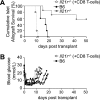Interleukin-21 is critically required in autoimmune and allogeneic responses to islet tissue in murine models
- PMID: 21357471
- PMCID: PMC3046847
- DOI: 10.2337/db10-1157
Interleukin-21 is critically required in autoimmune and allogeneic responses to islet tissue in murine models
Abstract
Objective: Type 1 diabetes is an incurable chronic autoimmune disease. Although transplantation of pancreatic islets may serve as a surrogate source of insulin, recipients are subjected to a life of immunosuppression. Interleukin (IL)-21 is necessary for type 1 diabetes in NOD mice. We examined the efficacy of an IL-21-targeted therapy on prevention of diabetes in NOD mice, in combination with syngeneic islet transplantation. In addition, we assessed the role of IL-21 responsiveness in islet allograft rejection in mouse animal models.
Research design and methods: NOD mice were treated with IL-21R/Fc, an IL-21-neutralizing chimeric protein. This procedure was combined with syngeneic islet transplantation to treat diabetic NOD mice. Survival of allogeneic islet grafts in IL-21R-deficient mice was also assessed.
Results: Evidence is provided that IL-21 is continually required by the autoimmune infiltrate, such that insulitis was reduced and reversed and diabetes inhibited by neutralization of IL-21 at a late preclinical stage. Recovery from autoimmune diabetes was achieved by combining neutralization of IL-21 with islet transplantation. Furthermore, IL-21-responsiveness by CD8+ T-cells was sufficient to mediate islet allograft rejection.
Conclusions: Neutralization of IL-21 in NOD mice can inhibit diabetes, and when paired with islet transplantation, this therapeutic approach restored normoglycemia. The influence of IL-21 on a graft-mounted immune response was robust, since the absence of IL-21 signaling prevented islet allograft rejection. These findings suggest that therapeutic manipulation of IL-21 may serve as a suitable treatment for patients with type 1 diabetes.
Figures






Comment in
-
Cytokines and type 1 diabetes: a numbers game.Diabetes. 2011 Mar;60(3):697-9. doi: 10.2337/db10-1782. Diabetes. 2011. PMID: 21357470 Free PMC article. No abstract available.
References
-
- Anderson MS, Bluestone JA. The NOD mouse: a model of immune dysregulation. Annu Rev Immunol 2005;23:447–485 - PubMed
-
- Bach JF, Mathis D. The NOD mouse. Res Immunol 1997;148:285–286 - PubMed
-
- Green EA, Flavell RA. The initiation of autoimmune diabetes. Curr Opin Immunol 1999;11:663–669 - PubMed
-
- Gazda LS, Charlton B, Lafferty KJ. Diabetes results from a late change in the autoimmune response of NOD mice. J Autoimmun 1997;10:261–270 - PubMed
-
- André-Schmutz I, Hindelang C, Benoist C, Mathis D. Cellular and molecular changes accompanying the progression from insulitis to diabetes. Eur J Immunol 1999;29:245–255 - PubMed
Publication types
MeSH terms
Substances
LinkOut - more resources
Full Text Sources
Other Literature Sources
Medical
Molecular Biology Databases
Research Materials

